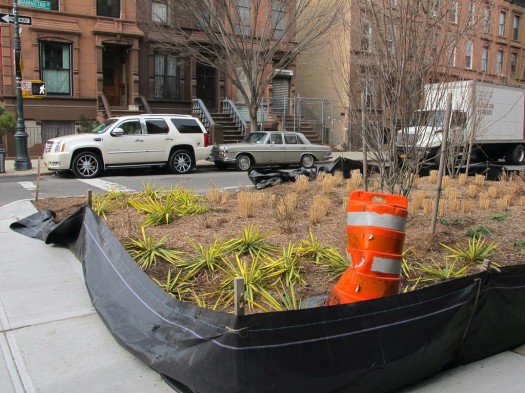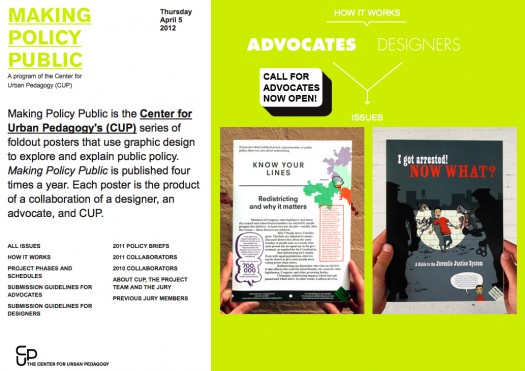
We are celebrating 15 years — and counting — of stories that are deeply researched and deeply felt, that build a historical record of what the city has been.
We are celebrating 15 years — and counting — of stories that are deeply researched and deeply felt, that build a historical record of what the city has been.

The Taxi of Tomorrow, the Nissan NV200 | via nyc.gov.
THE TAXI OF TOMORROW
The “Taxi of Tomorrow”, the Nissan NV200, the first taxi specifically designed and engineered for driving in New York City, has been unveiled. While the new cab will feature some major safety innovations, including airbags for passengers and lighter sliding doors, they are neither ADA compliant nor are they hybrids. These are two big criticisms. Nonetheless, the new features emerge from design process that responded specifically to the experience of New York City taxi drivers and passengers, rather than retrofitting an existing model of car, according to the Design Trust for Public Space. The Design Trust has led a series of strategic projects (Designing the Taxi, Taxi 07 and Roads Forward) over the past seven years that paved the way for the Taxi and Limousine Commission to implement change. Some of the new features featured on the NYC.gov’s Taxi of Tomorrow page might make you feel like you’re living in the future, like the charging stations featuring one regular outlet and two USB passenger ports. Others have been a long time coming, like the passenger reading lights or the and the “anti-bacterial, non-stick seats.” And even if the cars aren’t hybrids, the Nissan NV200 could be manufactured with fully electric power in the future, as soon as 2017. Check out the coverage at The New York Times and at Switchboard.
FINANCING INFRASTRUCTURE
While the federal government has lost some steam on innovative infrastructure financing, cities and states are picking up the slack. Chicago’s Mayor Rahm Emmanuel announced some ambitious plans for public works projects while Governor Cuomo started allocating funds from the newly created infrastructure bank for New York before a governing board has even been put in place. Cuomo’s $1.2 billion in funding is on top of the already allotted $1.6 billion devoted to infrastructure projects and will go to fixing New York’s rapidly deteriorating roads and bridges and the $5 billion Tappan Zee Bridge project. While all of this sounds very exciting, Robert Yaro, president of the Regional Plan Association pointed out that not only did these projects “have to happen,” but New York has been slowly siphoning money away from roads and bridge projects over the years so that many of our roads and bridges are in critical condition. The difference, of course, between Chicago and New York City is that Chicago’s mayor has control over its city transit systems whereas in New York City, the MTA is run at the state level. And in a mayoral race that seems to have already begun, one mayoral candidate, Tom Allon, has laid out a plan for the city to retake control over its own transit and roads.

Bioswale under construction at 122nd St. and Manhattan Ave. | Photo by Flickr user Kristine Paulus.
GREEN INFRASTRUCTURE STORMWATER SOLUTIONS
New York City has long had a stormwater retention issue: every time we get a big storm our storm sewers overflow, inundating our waterways with waste water. But a wide range of green infrastructure projects designed to redress this problem — UO readers will remember, in particular, the bluebelt throughout Staten Island and a project to prove the green infrastructure potential of rooftop farms — are proliferating. As of last month, we learned part of the uptick in projects with a green infrastructure component can be attributed to the very large carrot of “$2.4 billion in public and private investment towards the plan over the next 18 years, with $187 million to be spent over the next three years” according The New York Times’ Green blog. With this new funding, the City will be installing bioswales, essentially super deep tree wells that absorb excess water, in the areas with the worst flooding problems. Read more at The Dirt.
WASTE SOME TIME WITH THE 1940 CENSUS
Every time the Census Bureau releases data, it’s always endlessly fascinating, reframing our understanding contemporary American demographic and economic realities, spawning hundreds (if not thousands) of serious articles about the data’s implications. But the U.S. National Archives’ recent release of the 1940 census data just might provide something even more absorbing: many hours of wasted time. The archive hasn’t been fully digitized, just scanned, so they’re searchable by geography rather than family name and it takes some scrolling to find what you’re looking for, but you can still have a lot of fun imagining the people that lived on your block: their names, ages, occupation, whether they rented or owned, country or state of origin, how much they earned in a year and how much they paid in rent, not to mention the shape of a city that had not yet experienced urban renewal or interstate highways, a city in which trains still ran on the High Line and Penn Station was grand and romanesque. Start your search now.
WILLETS POINT REDEVELOPMENT CLEARS HURDLE
The proposed redevelopment for Willets Point could either bring about the next great New York neighborhood or merely signal the displacement and demise of a bustling hub of small, owner operated auto repair and salvage businesses. We took a look at the human face of this urban policy issue a couple weeks ago. And now the Federal Highway Authority has made a decision that could tip the scales in favor of the City’s plans: the FHA has approved the construction of two highway on ramps between the neighborhood of Willets Point and the Van Wyck. While this doesn’t necessarily mean that the city will be able to move forward with its redevelopment plan, it makes it a lot more likely.

Making Policy Public Call for Advocates | Center for Urban Pedagogy.
MAKING POLICY PUBLIC
CUP is looking for a new project for the 2012/2013 editions of the Making Policy Public series. CUP works with community organizations and advocacy groups that serve a constituency that would directly benefit from a visual break-down of their issue, and pair these needs with the skills of selected graphic designers. Past issues of Making Policy Public include Vendor Power!, for which they matched designer Candy Chang with The Street Vendor Project to explain the regulations that most impact street vendors to those same street vendors, and Predatory Equity, for which designer Glen Cummings worked with Tenants and Neighbors and the Urban Homesteading Assistance Board. Both Chang and Cummings shared some of their process with us in a pair of features a couple years ago. More information, as well as the application, is available here.
POST PRESS PLOT
For our readers in the Charlottesville, VA area, Cassim Shepard, UO’s editor, will be talking at UVA tonight about blogging, architecture and urbanism at a panel discussion called “Post Press Plot” alongside BLDGBLOG‘s Geoff Manaugh and Landscape Urbanism‘s Sara Peck.
The Roundup keeps you up to date with topics we’ve featured and other things we think are worth knowing about.
The views expressed here are those of the authors only and do not reflect the position of The Architectural League of New York.